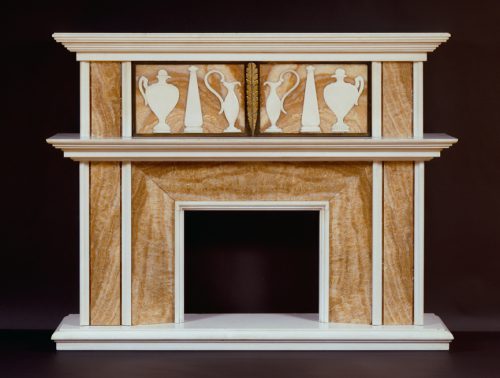9743 AN EXTRAORDINARY ART DECO PERIOD ORIENTAL ALABASTER AND STATUARY MARBLE CHIMNEYPIECE IN THE ‘ANTIQUE’ TASTE Rome. Circa 1940. Measurements: Height: 67″ (170 cm) Width: 53 1/8″ (135 cm) Depth 15 3/4″ (40cm)

Research
Of Oriental alabaster and statuary marble. The projecting molded statuary cornice above an Oriental alabaster frieze with applied statuary vases and obelisks in the antique taste is set with two concealed doors with foliate ormolu handles. The projecting molded statuary shelf above an Oriental alabaster beveled surround with a thin statuary fillet defining a rectangular aperture. The continuous Oriental alabaster flanks edged with vertical molded fillets. The whole raised on a solid statuary molded hearth.
Provenance:
By repute, a villa in EUR, Rome.
Removed from an important Genoese private home.
This chimney is designed in the Art Deco style, which favored bold, geometric forms in a departure from the organic, feminine shapes and pale colors of the Art Nouveau. After the restraint observed during World War I, designers referred to earlier movements for inspiration, including Neoclassicism. Much like during the neoclassical movement of the 18th century, a revived enthusiasm for antiquity was initiated, and artists and architects of the 20th century were able to travel to archaeological sites of interest, such as Tutankhamun’s tomb in the Egyptian Valley of Kings, discovered in 1922, as well as Pompeii and Herculaneum.
The shape, proportions and classical imagery of this piece are related to those of the fireplace designed by Giovanni Muzio for the marble hall of the Triennale exhibition in Monza in 1930. The room was planned to show off the beauty of Italian marble and the skills of its craftsmen in a classical setting. The Muzio fireplace itself is surmounted by a large and broad obelisk inlaid with panels of highly figured marble. The doorways either side, which are contained within arches, are flanked by marble urns.1 These motifs are echoed on this alabaster and white marble fireplace along the frieze, where the obelisks, vases and ewers are silhouetted in low relief against the alabaster background, recalling Roman bas reliefs.
The chimney was made during the dictatorship of Benito Mussolini, whose promotion of “Romanitas” (Roman-ness), emphasized the glories of ancient Rome, including his comparison between himself and Caesar Augustus. This was also expressed in architecture and decoration, the most famous manifestation of which is EUR, or Esposizione Universale Roma, a large suburban area in Rome built for the World Fair by Mussolini in the 1930s, where this chimneypiece reputedly once stood. EUR’s most iconic structure is the Palazzo della Civiltà Italiana, better known as the Square Colosseum, which was built circa 1938 in celebration of 20 years of fascism as a radically austere version of the great original eponymous structure.
It is interesting to note that the frieze of the chimneypiece to which the “antique” vases and obelisks are applied actually consists of a pair of doors, which open to reveal a cavity behind. They are centered by a gilt-bronze palm leaf, the Roman symbol of victory.
Footnotes:
1. Michail, M. Cristina Tonelli. Il Design in Italia 1925-43. Laterza, 1987. 28.

Comments are closed.